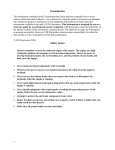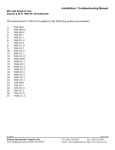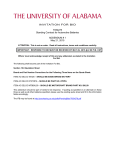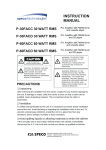Download Understanding Electronic Test Equipment
Transcript
Introduction The information contained in this Troubleshooting Guide has been compiled from various sources within the marine industry. Any reference to a specific product or brand is not intended for commercial purposes. References to test equipment and products are based upon the information available to the staff of CDI Electronics. This information is designed for use as a reference guide by a professional marine technician. CDI Electronics cannot be held liable for the misuse or abuse of the information contained herein. The staff tries to make the information as accurate as possible. However, CDI Electronics cannot assume responsibility for either the data accuracy or the consequences of the data's application. © CDI Electronics 2004 Safety Issues Always remember to treat the outboard engine with respect. The engine uses high voltage for ignition and contains several moving components. Always be aware of moving mechanical parts, the surrounding area, and the position of your hands and body near the engine. • Never touch electrical components with wet hands. • Whenever the power source is not needed, disconnect the cable from the negative terminal. • Never reverse the battery leads when you connect the battery or disconnect the terminals while the engine is running. • Never touch high-tension leads (spark plug leads) with any ungrounded tools while the engine is running. • Never install equipment with requirements exceeding the generating power of the engine. Reference the service manual for values. • Attempt to protect the electronic components from water. • Insure fuel lines, harnesses, and oil lines are properly routed. Failure to follow this rule could result in a fire hazard. • Make sure all ground leads are clean and tight. 2 Recommended Marine Shop Electrical Test Equipment and Tools The following is a listing of tools available from CDI Electronics and recommended for testing late model engines: Part Number 511-9764 Description Neon Spark Tester 511-9766 Sealed Spark Gap Tester 511-9770 Piercing Probes 511-9773 . 511-9775 DVA (Peak Voltage)Adapter 518-33A Load Resistor 518-80TK CDI 33 Meter Includes 511-9773 DVA Adapter Fluke Temperature Adapter 520-ST80 551-33GF DC Inductive Timing Light Gearcase Filler w/Check Valve 551-34PV Pressure/Vacuum Tester 551-5110 551-9765 553-2700 Flywheel Holder Spark Plug Wire Puller Amphenol Pin Tool Set 553-9702 Sensor Gap Gauge Tool 554-9706 Amp Pin Removal Tool 911-9783 912-9708 991-9705 511-6996 Bullet Connector Kit Marine Terminal Kit Dielectric Grease Remote Starter For OMC 511-7900 Remote Starter for Mercury 519-LB85 Load Bank Remarks/Use Sealed single cylinder has removable ground clamp can be used for running tests Allows for testing up to 8 cylinder for cranking tests. Sealed design reduces the chance of engine fire. Allows access to wires for testing without removing the connection. Tiny hole usually reseals itself. Unit automatically compensates for polarity. Can be used with most quality Multimeters Used to load the output of ignition modules when testing ignition coils. Meter has voltage, amperage, diode check and ohms DVA Adapter allows meter to read peak voltage Works with most digital Multimeters capable of reading millivolts. DC Powered timing light with a very bright strobe light. Universal design makes filling lower units easier. Check valve assembly helps prevent oil spills and makes filling easier. Repairable metal combination unit does both vacuum and pressure testing. Longer handle helps during use. Grounded design reduces the chances of shocking. Set contains 1 each of 553-2697 (Insertion), 553-2698 (Pin Removal) and 553-2699 (Socket Removal) Used to set the timer-base air gap on 1973-1978 OMC 3 and 4 cylinder engines with screw terminal power packs. Used to remove the connector pins in the ignition system on Chrysler/Force engines using the Prestolite type ignitions. Also used on the Mercury TPI sensor connectors. Contains 10 pieces each of the male, female and sleeves. Contains 100+ pieces of hard to find terminals and heat shrink. Use to keep water and corrosion out of connectors. Used to replace the boat-side harness for engine testing, Fits most OMC engines 1969 to 2000. Used to replace the boat-side harness for engine testing, Fits most Mercury engines 1979 to 2000. Used to load the battery when testing the battery charging output. Optional Equipment 511-4017 OMC Optical Sensor Tester 511-0401 CDI 2 Cylinder Ignition Tester 520-ST84 Ferret Ultra Bright Timing Light Unique handheld tester that will efficiently test the optical ignition sensor. New hand-held ignition tester generates high-voltage stator and low voltage trigger signals to test a variety of 2 cylinder ignition systems. Engine specific adapters are required. Includes 511-0402, 511-0403 and 511-0404 adapters. Ultra bright timing light is visible in bright sunlight. Also has a built-in tachometer for 2 and 4 stroke engines. This feature is a valuable diagnostic tool when troubleshooting ignition system problems. 3 Tricks to Testing with Minimal Test Equipment All Engines Please keep detailed records when you repair an engine. If an engine comes in with one cylinder not firing, mark which one on the work order/history. Intermittent Firing: This problem can be very hard to isolate. A good inductive tachometer can be used to compare the RPM on all cylinders up through WOT (wide-open throttle). A significant difference in the RPM readings can help pinpoint a problem quickly. Visually Check the Stator, Trigger, Rectifier/Regulator and Flywheel: Cracks, burned areas and bubbles in or on the components indicate a problem. If the battery charge windings on the stator are dark brown, black or burned on most or all of the posts, the rectifier/regulator is likely shorted as well. Any sign of rubbing on the outside of the stator indicates a problem in the upper or lower main bearings. A cracked trigger or outer charging magnets can cause many problems ranging from misfiring to no fire at all. Loose flywheel magnets can be dangerous, check the tightness of the bonding adhesive. Rectifier/Regulators can cause problems ranging from a high-speed miss to a total shutdown. An easy check is to disconnect the stator leads to the rectifier (Make sure to insulate them) and retest. If the problem is gone – replace the rectifier/regulator. Johnson/Evinrude Open Timer Bases: When all cylinders fire with the spark plugs out, but will not with them installed, try re-gapping the sensors using P/N: 553-9702 Gap Gauge. (See the section on OMC ADI Ignitions page 22-24). Engines with S.L.O.W. Features: If the customer is complaining that the engine won’t rev up and shakes real bad, the S.L.O.W. function could be activating. If the engine is NOT overheating, a temperature sensor or VRO sensor failing early can cause this problem. Disconnect the TAN wires at the power pack and retest. If the engine performs normally, reconnect the tan wires one at a time until the problem recurs, then replace the last sensor you connected. Make sure that all of the TAN wires are located as far as possible from the spark plug wires. Also check the blocking diode in the engine harness. Mercury 6 Cylinder Engines with ADI Ignitions If more than one cylinder is not firing: Replace BOTH switch boxes unless you can pin the problem down to the trigger. Replacing just one switch box can result in damage to the engine if the remaining switch box on the engine has a problem in the bias circuit. Always check the bias circuit: Disconnect the White/Black jumper between the switch boxes and check the resistance from the White/Black terminal on each switch box to engine ground. You should read 12-15,000 ohms on stock switch boxes, and 9,000-9,800 ohms on racing switch boxes. MAKE SURE THE READING IS THE SAME ON BOTH SWITCH BOXES! Any problem with the bias circuit and BOTH switch boxes must be replaced as a set. No Fire on 1, 3, 5 or 2, 4, 6: Swap the stator leads from one switch box to the other. If the problem moves, replace the stator. If the problem remains on the same cylinders, replace the switch box. If the stator is replaced and the problem is still present, try another flywheel. No Fire on One Cylinder: This can be caused by a defective blocking diode in the other switch box. Disconnect the White/Black jumper between the switch boxes and retest. If all cylinders are now firing, replace the switch box that was originally firing all three cylinders. To verify this condition, swap the trigger leads on the switch box that was originally firing all three cylinders. If the misfire moves to another cylinder, the switch box is bad. 4 Voltage Drop Measurement Start by using a good digital auto-ranging voltmeter capable of reading 1/10th of a volt. The use of an auto-ranging meter will allow for more accurate testing without damaging the meter due to an incorrect range setting. Remove the spark plug wires form the spark plugs and connect them to a spark gap tester and remove the emergency stop clip as well. This prevents the engine from starting and also reduces the chance of getting shocked by the ignition system. The use of an ohmmeter to test a conductor or switch contact for their condition is not the best tool to use. In most cases, it is preferable to use a volt drop test to make sure the conductor, as well as the connection, is in good condition. Before testing, remove and clean all battery cables and connection points. Testing the Positive Battery Cable to the Engine 1. 2. 3. 4. Select the DC Volts position on the meter. Connect the Red (Positive) lead on the meter to the positive battery POST. Connect the Black (Negative) lead on the meter to the starter solenoid terminal where the positive battery cable is connected. Using a remote start switch, activate the starter solenoid to spin the engine and observe the reading on the meter. A reading above 0.6V indicates a bad cable or bad connection. (a) If the meter reads above 0.6V, move the Black lead on the meter to the positive battery cable terminal on the starter solenoid and retest. If the reading drops to below 0.6V, the cable connection is bad. (b) If the meter still reads above 0.6V, move the Black lead on the meter to the positive battery cable terminal on the battery and retest. If the reading drops to below 0.6V, the cable is bad or undersized. Service Note: A bad power connection to the ignition or battery charging system can be found by connecting the Black lead on the meter to the power connection of the ignition system or charging system; then working your way back to the battery positive post. At no time should you see a reading above 1V. Testing the Negative Battery Cable to the Engine 1. 2. 3. 4. Select the DC Volts position on the meter. Connect the Black (Negative) lead on the meter to the negative battery POST. Connect the Red (Positive) lead on the meter to the engine block where the negative battery cable is connected. Using a remote start switch, activate the starter solenoid to spin the engine and observe the reading on the meter. A reading above 0.6V is an indicator of a bad cable or bad connection. (a) If the meter reads above 0.6V, move the Red lead on the meter to the negative battery cable terminal on the engine block and retest. If the reading drops to below 0.6V, the cable connection is bad. (b) If the meter still reads above 0.6V, move the Red lead on the meter to the negative battery cable terminal on the battery and retest. If the reading drops to below 0.6V, the cable is bad or undersized. A bad ground connection to the ignition and battery charging system can be found by connecting the Red lead on the meter to the ground connection of the ignition or battery charging system; then working your way back to the battery negative post. At no time should you see a reading above 1V. Johnson/Evinrude Model to Year Identification for 1980 and newer Engines I N T “INTRODUCES” R O D U 1 2 3 4 5 6 7 C E S 8 9 0 Example: J150TTLCE would be a 1989 150 HP Johnson and aE175STEU would be a 1997 175 HP Evinruide. 5 Engine Wiring Cross Reference Chart for Most Outboards Mercury Mercury PRE- 1978 1978 & UP Power Red Ign Switch Circuit Force Force PRE- 1994 1994 & UP Red Red Red/Purple White Purple Yellow Blue Red/Blue Gray Black Black Black Black Black Blk/Yellow Blk/Yellow White White Blk/Yellow Green Red Blue Yellow/Red Yellow/Red Brown Yellow Yellow/Red Brown Yellow/Red Green Purple Gray Yellow Green Yellow OMC Yamaha Red Red White Purple Eng Gnd Black Black Kill Circuit Orange Salmon White Eng Start Yellow Tach Brown Battery Charge Yellow/Red Yellow Yellow Yellow/Blk Yellow/Gry Stator CDI Power Red White Blue(a) Blue Blue/White Brown Brown/Yel Red Red/White Brown/Blk Green/Wht Brown/Wht Wht/Green Choke Gray Blue Yellow/Blk Purple/Wht Blue Green Yellow/Blk Orange Overheat Eng Temp Tan Tan (b) White/Blk(c) Pink Orange Tan Green/Yel Gray Tan Gray Suzuki Yellow Yellow/Red Yellow/Blk Blue Blue/White Blue Blue Brown Yellow Red Green Red Brown/Blue Red/White Black/Red Blk/Red Brown/Yel Green/Wht Wht/Green (a) Ignition Driver systems only, all others were battery driven systems. (b) The stripe color on the Tan wire indicates the temperature at which the sensor trips. (c) The White/Black wire is the cold engine temp indicator and shorts to Gnd at approx 105 deg F. Blk = Black Yel = Yellow 6 Wht = White Blk = Black Gry = Gray ABYC Recommended Boat Wiring Color Codes Color Function Yellow/Red Stripe (YR) Engine Start Circuit Brown/Yellow Stripe (BY) Bilge Blower Yellow Stripe (Y) Bilge Blower Dark Gray (Gy) Navigation Lights Dark Gray (Gy) Tachometer Brown (Br) Generator/Alternator Orange (O) Accessory Power Purple (Pu) Comments Alternate color is Yellow (Y) If used for DC negative, blower MUST be Brown/Yellow Stripe. Fuse or Switch to lights Charge Indicator Lights, Fuse or switch to pumps. Ammeter to alternator output and accessory fuse or switches. Distribution Panel accessory switch. Ignition switch to coil and electrical Ignition Instrument power instruments , Distribution Panel to electric instruments. Dark Blue Cabin and instrument lights Fuse or switch to lights. Light Blue (Lt Bl) Oil Pressure Oil sender to gauge. Tan Water Pressure Temperature sender to gauge. Pink (Pk) Fuel Gauge Fuel sender to gauge. Green/White Stripe Tilt/Trim down or in Tilt and Trim circuits Blue/White Stripe Tilt/Trim up or out Tilt and Trim circuits 7 Chrysler Troubleshooting Points Type Ignitions with Amplifiers (Power packs) (Preamps are electronic replacements for points) A large proportion of the problems with the battery CD units are caused by low battery voltage or bad ground connections. Low voltage symptoms are weak fire or erratic firing of cylinders. Maintenance free batteries are NOT recommended for this application. WARNING!! Battery reversal will cause severe damage to the CD module and rectifier. NOTE: The Chrysler CD modules are similar to the OMC CD modules with the exception of wire colors. The chart below will assist you as a general guideline for the Chrysler units: Red +12V from battery (RF Noise Filter) Blue +12V from the Key Switch Gray + Terminal of ignition coil White OEM Tachometer signal White/Black Stripe Points or Preamp Module Black Engine ground No Fire at All: 1. 2. 3. Clean all battery connections and engine grounds. Make sure the CD module is grounded. Units using rubber shock mounts require a ground wire fastened from the pack to the engine block. Connect a spark gap tester to the high tension lead coming from the ignition coil and set it to approximately ½”. If it fires when you crank the engine over, there is a problem in the distributor cap, rotor button or spark plug wires. Wiring Connection for Testing CD Module NOTE: Preamps are an electronic version of points and the ignition module will test the same for both. 4. 5. 6. Check voltage present on the blue wire at cranking. It MUST be at least 9½ volts. If not, the problem is likely in the harness, key switch, starter or battery. Connect a DC voltmeter to the white/black wire (while it is connected to the distributor) and rotate the engine. There should be some fluctuation in the meter reading. If the reading is high, and fails to move up and down, there is definitely a problem inside the distributor. If the reading is low, disconnect the white/black wire from the distributor and with the key switch turned on, strike the white/black wire against engine ground. The unit should fire each time. If it does, then the CD module is usually good and the points (or Preamp) require checking. If the CD module fails to fire with this test, then the CD module is usually bad. Check DVA voltage on the gray wire going to the coil, it should be approximately 200 volts at cranking. If the voltage is correct, replace the coil with another coil and retest or use a load resister if another coil is not available. A coil that is shorted internally will give a low reading. In this case replace the coil and retry. After repairing the engine, check the battery voltage at approximately 3500 RPM, The MAXIMUM allowable voltage reading is 16 volts and the minimum is 12V. Running below 12V or over 16 volts will damage the ignition. Check for loose connections or a bad battery. 8 1. 2. 3. 4. 5. Disconnect the white and blue kill wires from the CD Module and retest. If the engine starts and runs, the key-switch or kill circuit is bad. Connect a DC voltmeter from the kill wires to engine ground and turn the ignition switch on and off several times. At no time should you see battery voltage on the kill circuit. Connect a spark gap tester to all cylinders and test with the spark plugs in and out. If the coils will not fire with the spark plugs in, check compression with the spark plugs removed from all cylinders. A blown head gasket on these engines can prevent the coils from firing with the spark plugs installed. This is caused by a hard to explain problem with the triggering circuit. Crank the engine with the starter and then stop. Check the DVA voltage on terminals T1 and T4. You should read between 170 and 270 volts Positive on terminal T1 and between 170, and 270 volts Negative on terminal T4. (Remember that some DVA adapters are not polarized and will read the same regardless of the polarity). If there is a low reading on one of the terminals, disconnect the white/blue and green/white trigger wires, then retest. If the readings are now correct, one of the trigger modules is bad. A continued low reading may be caused by a bad capacitor. To test, use a couple of jumper wires and swap the green and white capacitor wires going to terminals T1 and T4. If the low reading remains on the same terminal, the CD is bad. If it moves when you move the capacitor wires, the capacitor is shorted. Check to see if the ignition coils are wired correctly. The #1 coil on a two cylinder engine and the #1 & 2 cylinder on a four cylinder engine are wired as NEGATIVE GROUND. The #2 coil on a two cylinder engine and the #3 & 4 cylinder on a four cylinder engine are wired as POSITIVE GROUND. 9 Chrysler/Force Troubleshooting Magnapower II Systems Chrysler Troubleshooting Capacitive Discharge Module with Alternator (ADI – Alternator Driven Ignition) General Troubleshooting 1. 2. 3. 4. Disconnect the kill wires from the CD and connect a DC voltmeter between the kill wires and engine ground. Turn the ignition switch on and off several times. If, at any time, you see voltage appearing on the meter, there is a problem in the harness or ignition switch. At NO TIME SHOULD YOU SEE BATTERY VOLTAGE ON A KILL CIRCUIT. Check the flywheel for a broken or loose magnet. Check for broken wires and terminals, especially inside the plastic plug-in connectors. We recommend that you remove the pins from the connectors using the CDI 511-9706 pin removal tool and visually inspect them. Visually inspect the stator for burned or discolored areas. If found, replace the stator. If the areas are on the battery charge windings, it indicates a possible problem with the rectifier. IF NO FIRE ON ANY CYLINDER: 1. 2. 3. 4. Disconnect all kill wires AT THE PACK. Check for broken or bare wires on the unit, stator and trigger. Using the CDI meter with the 511-9773 peak reading adapter, or CD-77 and 511-9770 piercing probes, measure DVA voltage of the stator between the output wire sets. With everything connected, reading’s should be approximately 180 volts or more. Resistance readings between the stator wire sets range from 680 – 800 ohms (factory) and 400 – 500 (CDI/RAPAIR). Disconnect the rectifier. If the engine fires, replace the rectifier. NO FIRE OR INTERMITTENT ON ONE CYLINDER: 1. 2. 3. Check the stator resistance, you should read 680-800 ohms (factory) and 250-350 ohms (CDI/RAPAIR) DVA 180V or more from blue to yellow (Note – On some two cylinder engines, the stator has two blue wires and no yellow wire. The stator will read from blue to blue). All stator wires should read open to engine ground. Check the trigger resistance, trigger wire sets read approximately 50 ohms between the wire sets (DVA-5V or more), and open to engine ground. If readings are good, disconnect kill wire from one pack. If the dead cylinder starts firing, the problem is likely the blocking diode in the opposite pack. NO FIRE ON TWO CYLINDERS: If two cylinders from the same CD unit will not fire, the problem is usually in the stator. Test per above. ENGINE WILL NOT KILL: Check kill circuit in the pack by using a jumper wire connected to the kill wire coming out of the pack and shorting it to ground. If this kills the pack, the kill circuit in the harness or on the boat is bad, possibly the ignition switch. COILS ONLY FIRE WITH THE SPARK PLUGS OUT: Check for dragging starter or low battery causing slow cranking speed. DVA test stator and trigger. HIGH SPEED MISS: 1. 2. Using the CDI meter with the 511-9773 peak reading adapter, (or CD-77) and 511-9770 piercing probes, DVA check stator voltage to each pack at high speed. If it exceeds 400 volts, replace the pack. Disconnect the rectifier. If the engine fires, replace the rectifier. Two Cylinder Engines with Combination CD Module with Built-in Ignition Coils NO FIRE OR INTERMITTENT ON ONE CYLINDER: 1. 2. 3. Check the stator resistance, you should read 680-800 ohms (factory) and 250-350 ohms (CDI/RAPAIR) DVA 180V or more from blue to yellow (Note – On some two cylinder engines, the stator has two blue wires and no yellow wire. The stator will read from blue to blue). All stator wires should read open to engine ground. Check the trigger resistance, trigger wire sets read approximately 50 ohms between the wire sets (DVA-5V or more), and open to engine ground. If readings are good, disconnect kill wire from one pack. If the dead cylinder starts firing, the problem is likely the blocking diode in the opposite pack. ENGINE WILL NOT SHUT OFF: Check kill circuit in the pack by using a jumper wire connected to the kill wire coming out of the pack and shorting it to ground. If this kills the pack, the kill circuit in the harness or on the boat is bad, the ignition switch could also be bad. 10 Two Cylinder Engines Using a Separate Switch Box and Ignition Coils 1. 2. 3. 4. Disconnect the stop wires from the CD and connect a DC voltmeter between the stop wires and engine ground, turn the ignition switch on and off several times. If, at any time, you see voltage appearing on the meter, there is a problem in the harness or ignition switch. At NO TIME SHOULD YOU SEE BATTERY VOLTAGE ON A STOP CIRCUIT. Check the flywheel for a broken or loose magnet. Check for broken wires and terminals, especially inside the plastic plug-in connectors. We recommend that you remove the pins from the connectors using the CDI 511-9706 pin removal tool and visually inspect them. Visually inspect stator for burned or discolored areas. If found, replace the stator. If the areas are on the battery charge windings, it indicates a possible problem with the rectifier. IF NO FIRE ON EITHER CYLINDER: 1. 2. 3. 4. Disconnect all stop wires AT THE PACK. Check for broken or bare wires on the ignition module, stator and trigger. Using the CDI meter with the 511-9773 peak reading adapter, or CD-77 and 511-9770 piercing probes, measure DVA voltage of the stator between the output wire sets. With everything connected, reading’s should be approximately 180 volts or more. Resistance readings between the stator wire sets ranges from 680 – 800 ohms (factory) and 250-350 ohms (CDI/RAPAIR). Disconnect the rectifier. If the engine now has spark, replace the rectifier. NO SPARK OR INTERMITTENT ON ONE CYLINDER: 1. 2. 3. Check the stator resistance, you should read 680-800 ohms (factory) and 400 – 500 (CDI/RAPAIR) DVA 180V or more from blue to yellow (Note – On some two cylinder engines, the stator has two blue wires and no yellow wire. The stator will read from blue to blue). All stator wires should read open to engine ground. Check the trigger resistance, trigger wire sets read approximately 50 ohms between the wire sets (DVA-5V or more), and open to engine ground. If readings are good, disconnect stop wire from one pack. If the dead cylinder starts sparking, the problem is likely the blocking diode in the opposite pack. ENGINE WILL NOT STOP: Check the stop circuit in the pack by using a jumper wire connected to the white stop wire coming out of the pack and shorting it to the white stop wire coming out of the other pack. If this stops all spark from the pack, the stop circuit in the engine harness or on the boat is bad, the ignition switch could also be bad. COILS ONLY HAS SPARK WITH THE SPARK PLUGS OUT: Check for dragging starter or low battery causing slow cranking speed. DVA test stator and trigger. HIGH SPEED MISS: 1. 2. Using the CDI meter with the 511-9773 peak reading adapter, (or CD-77) and 511-9770 piercing probes, DVA check stator voltage to each pack at high speed. If it exceeds 400 volts, replace the pack. Disconnect the rectifier. If the engine now has spark, replace the rectifier. Three and Four Cylinder Engines Using Separate Switch Boxes and Ignition Coils 1. 2. 3. 4. Check for broken wires and terminals, especially inside the plastic plug-in connectors. We recommend that you remove the pins from the connectors using the CDI 511-9706 pin removal tool and visually inspect them. Check the flywheel for a broken or loose magnet. Disconnect the stop wires from the CD and connect a DC voltmeter between the stop wires and engine ground, turn the ignition switch on and off several times. If, at any time, you see voltage appearing on the meter, there is a problem in the harness or ignition switch. At NO TIME SHOULD YOU SEE BATTERY VOLTAGE ON A STOP CIRCUIT. Visually inspect stator for burned or discolored areas. If found, replace the stator. If the areas are on the battery charge windings, it indicates a possible problem with the rectifier. IF NO SPARK ON ANY CYLINDER: 1. 2. 3. 4. Disconnect stop wire AT THE PACK. Check for broken or bare wires on the unit, stator and trigger. Using the CDI meter with the 511-9773 peak reading adapter, or CD-77 and 511-9770 piercing probes, measure DVA voltage of the stator between the output wire sets. With everything connected, reading s should be approximately 180 volts or more. Resistance readings between the stator wire sets range from 680 – 800 ohms (factory) and 250-350 ohms (CDI/RAPAIR). Disconnect the rectifier. If the engine has spark, replace the rectifier. 11 Chrysler/Force Troubleshooting Chrysler/Force Troubleshooting Prestolite Capacitive Discharge Module with Alternator (ADI – Alternator Driven Ignition) Chrysler/Force Troubleshooting Capacitive Discharge Module with Alternator (ADI – Alternator Driven Ignition) Three and Four Cylinder Engines Using Separate Switch Boxes and Ignition Coils (Continued) NO SPARK OR INTERMITTENT ON ONE CYLINDER: 1. 2. Check the stator and trigger resistance; the trigger wire sets should read approximately 50 ohms between the wire sets (DVA-5V or more), the stator should read 680-800 ohms (factory) and 250-350 ohms (CDI/RAPAIR) DVA 180V or more from blue to yellow. If readings are good, disconnect the stop wire from one pack. If the dead cylinder starts sparking, the problem is likely the blocking diode in the opposite pack. NO SPARK ON TWO CYLINDERS: If two cylinders from the same CD unit will not spark, the problem is usually in the stator. Test per above. ENGINE WILL NOT SHUT OFF: Check the stop circuit in the pack by using a jumper wire connected to the stop wire coming out of the pack and shorting it to ground. If this stops the pack from sparking, the stop circuit in the harness or on the boat is bad, the ignition switch could also be bad. COILS ONLY HAS SPARK WITH THE SPARK PLUGS OUT: Check for dragging starter or low battery causing slow cranking speed. DVA test stator and trigger. HIGH SPEED MISS: 1. 2. Using the Fluke meter with the 511-9773 peak reading adapter, (or CD-77) and 511-9770 piercing probes, DVA check stator voltage to each pack at high speed. If it exceeds 400 volts, replace the pack. Disconnect the rectifier. If the engine now has spark, replace the rectifier. Pack #1 (Firing #1 and #2 Cylinders) Pack: Pack: Pack: Pack #3 (Firing #4 and #5 Cylinders) White/Orange Stripe Trigger: White/Orange Stripe White/Yellow White/Yellow (a) White/Red White/Red (a) White/Green Stripe White/Green Stripe Brown/Yellow Stripe Stator: Brown/Yellow Stripe Brown/Blue Stripe Brown/Blue Stripe Orange/Blue Coil: White Blue/Red White Pack: Pack: Pack: White/Orange Stripe Trigger: White/Orange Stripe White/Yellow White/Yellow (a) White/Red White/Red (a) White/Green Stripe White/Green Stripe Brown/Yellow Stripe Stator: Brown/Yellow Stripe Brown/Blue Stripe Brown/Blue Stripe Orange/Blue Coil: White Blue/Red White P Pack #2 (Firing #3 Cylinder) Pack: Pack: Pack: White/Orange Stripe Trigger: White/Orange Stripe White/Yellow White/Yellow (a) White/Red No Connection White/Green Stripe No Connection Brown/Yellow Stripe Stator: Brown/Yellow Stripe Brown/Blue No Connection (must be connected to the blue terminal on pack 1) Orange/Blue Coil: White Blue/Red No Connection (a) CDI replacement triggers do not have a connection for this wire from the power pack as the new trigger uses a common ground wire. This allows the wires going to the power pack from the trigger to be larger and more durable. The power pack uses that color as a ground wire for the trigger. Color Code Cross Reference FUNCTION Trigger Trigger Trigger Trigger Stator Stator Pack Output to Coil Pack Output to Coil Ignition Coil Stop Circuit 12 OLD Orange Green Red White/Green Stripe Blue Yellow Orange Red White White NEW White/Orange Stripe White/Yellow Stripe White/Red Stripe White/Green Stripe White/Green Stripe Brown/Blue Stripe Brown/Yellow Stripe Orange/Blue Blue/Red Orange/Blue Black/Yellow CDI ELECTRONICS (DVA) PEAK READING VOLTAGE AND RESISTANCE CHARTS NOTICE: These charts were compiled using the CDI 511-9773 Peak Adapter with a shielded Digital Multimeter. NOTE: The resistance readings are given for a room temperature of 68°F. Higher temperatures will cause a slightly higher resistance reading. DVA readings should always be taken with everything hooked up with the exception of the kill circuit. The CDI peak reading voltage adapter is specifically designed to work with shielded Digital Multimeters. This adapter will simplify the testing of electronic ignition systems, stators, sensors and charging systems. The DVA readings will be approximately the same as any other DVA meter and the specifications listed in the service manuals can be followed without problems (Hopefully a little easier to you). The CDI piercing probe set (511-9770) and the pack load resister (511-9775) are highly recommended for use with this adapter. INSTRUCTIONS 1. Plug the adapter into the shielded Digital Multimeter with the (+) rib side pin in the (V, Ohms) jack and the other pin in the (COM) jack. 2. Set the digital voltmeter to DC Volts (the purpose of the adapter is to convert and store the voltage so that it can be read by a meter). 3. Connect the probes to the component to be measured. NOTE: The adapter will automatically compensate for polarity and all readings will be peak voltage. See the following pages for readings of Chrysler, Force, Mercury, OMC (Johnson/Evinrude), OMC Sea Drive and Yamaha engines. Other ignitions can be tested using test results given by the manufacturer of the equipment or by comparing a known good system to a suspect one. Please forward any additional readings you would like to have included in future printings. “Big enough to do the job, small enough to care” • Tech Support 866-423-4832 • Fax 256-772-5701 • www.rapair.com 61 Chrysler DVA (PEAK READING) and RESISTANCE CHARTS HP Year Model Ignition Type Part Number 7.5 7.5 7.5 8 1972 1977 19791984 1982 BOC/B1D /HOC/H1D BOC/B1C /HOC/H1C All Models 82H8J -87H8A 9.9 19791984 A, B 10 19761978 W/CD & Alternator 12 1979 W/CD & Alternator 15 1976 1984 W/CD & Alternator 20 1979 1981 W/CD & Alternator 25 1983 1984 W/CD & Alternator 30 1979 1982 W/CD & Alternator 35 1978 1984 W/CD & Alternator 55 1977 1980 W/Magna-power II 55 1981 1983 All Models 60 1984 All Models 65 1977 1978 W/Magna-power II 80 1983 1984 W/CD & Alternator 90 1983 1984 W/CD & Alternator 105 1976 BD/BE/HA/HD/HE 115 1983 1984 W/CD & Alternator 120 1976 BD/BE/HD/HE 125 1981 1982 135 1976 525475 525475 525475 525475 510301 1160301* 510301 1160301* 510301 1160301* 510301 1160301* 529301 1169301* 529301 1169301* 529301 1169301* 529301 1169301* Ohms 680-850 300-400* 680-850 300-400* 680-850 300-400* 680-850 300-400* 680-850 300-400* 680-850 300-400* 680-850 300-400* 680-850 300-400* 680-850 300-400* 680-850 300-400* 680-850 300-400* 680-850 300-400* 4743011 475301 1165301* 475301 1165301* Not Applicable 4743011 475301 1165301* 475301 1165301* Not Applicable 4743011 475301 1165301* Not Applicable Not Applicable W/CD & Alternator 4743011 475301 1165301* BD/BE/ HD/HE 4743011 Not Applicable Grn = Green Wht/Grn = White/Green Stripe * Indicates a part manufactured by CDI Electronics 62 Stator 680-850 300-400* 680-850 300-400* 680-850 300-400* 680-850 300-400* 680-850 300-400* 680-850 300-400* Stator Stator DVA Reading Output Colors 180V+ Blue - Blue 180V+ Blue - Blue Trigger Trigger Trigger DVA Reading Ohms Output 48-52 0.5V+ Colors Orange to Grn Red to Wht/Grn N/A 125-140 0.5V+ Orange to Grn Red to Wht/Grn N/A 125-140 N/A 125-140 N/A 125-140 0.2-1.0 8001100 0.2-1.0 8001100 0.2-1.0 8001100 0.2-1.0 8001100 0.2-1.0 8001100 0.2-1.0 8001100 0.2-1.0 8001100 0.2-1.0 8001100 0.2-1.0 2002000 0.2-1.0 8001100 0.2-1.0 8001100 0.2-1.0 2002000 0.2-1.0 8001100 0.2-1.0 8001100 0.2-1.0 2002000 0.2-1.0 8001100 48-52 180V+ Blue - Blue 48-52 0.5V+ 180V+ Blue - Blue 48-52 0.5V+ 180V+ Blue - Yellow 48-52 0.5V+ 180V+ Blue - Yellow 48-52 0.5V+ 180V+ Blue - Yellow 48-52 0.5V+ 180V+ Blue - Yellow 48-52 0.5V+ 180V+ Blue - Yellow 48-52 0.5V+ 180V+ Blue - Yellow 48-52 0.5V+ 180V+ Blue - Yellow 48-52 0.5V+ 180V+ Blue - Yellow 48-52 0.5V+ 180V+ T1 & T4 to Eng Gnd Open 0.5V+ 180V+ Blue - Yellow 48-52 0.5V+ 180V+ Blue - Yellow 48-52 0.5V+ 180V+ T1 & T4 to Eng Gnd Open 0.5V+ 180V+ Blue - Yellow 48-52 0.5V+ 180V+ Blue - Yellow 48-52 0.5V+ 180V+ T1 & T4 to Eng Gnd Open 0.5V+ 180V+ Blue - Yellow 48-52 0.5V+ 180V+ T1 & T4 to Eng Gnd Open 0.5V+ 180V+ Blue - Yellow 48-52 180V+ T1 & T4 to Eng Gnd Open Orange to Grn Red to Wht/Grn Orange to Grn Red to Wht/Grn Orange to Grn Red to Wht/Grn Orange to Grn Red to Wht/Grn Orange to Grn Red to Wht/Grn Orange to Grn Red to Wht/Grn Orange to Grn Red to Wht/Grn Orange to Grn Red to Wht/Grn Orange to Grn Red to Wht/Grn Orange to Grn Red to Wht/Grn Between Terminals Orange to Grn Red to Wht/Grn Orange to Grn Red to Wht/Grn Between Terminals Orange to Grn Red to Wht/Grn Orange to Grn Red to Wht/Grn Between Terminals Orange to Grn Red to Wht/Grn Ignition Coil Primary Output Ohms 0.2-1.0 2002000 0.5V+ Between Terminals Orange to Grn Red to Wht/Grn 0.2-1.0 8001100 0.5V+ Between Terminals 0.2-1.0 2002000 Glossary of Terms ADI – Alternator Driven Ignition, consists of a flywheel, stator, trigger and ignition module. ADTC - After Top Dead Center Reference on ignition timing. BTDC - Before Top Dead Center Reference on ignition timing. CD Ignition – Capacitive Discharge Ignition. The capacitor stores the power developed by a stator or inverter and uses a SCR to deliver the power to the ignition coil. CDM – Capacitive Discharge Module. The CDM is a combination of the switch box and ignition coil. Crank - Refers to the engine being turned over with the starter, not running. Spark plug wires are usually connected to a spark gap tester. DVA – Direct Voltage Adapter. Also known as Peak voltage. The term refers to the peak voltage as read by a specialized meter or a multimeter using a adapter to convert the peak voltage in the ignition system to a DC value. Regular meters cannot read the voltages due to the frequency and duration of the pulses in the system. Power Pack – Term used by Johnson/Evinrude for the ignition module. RPM – Revolutions per minute. The number of times the engine rotates in one minute. S.L.O.W. – Speed Limiting Oil Warning system. Limits the RPM of the engine to approximately 2500 RPM in order to reduce the damage to the engine caused by a no oil or overheat condition. Spark Tester - Device used to check for spark from the ignition coil to the spark plug. Testers are normally available in 1, 4, 6 and 8 cylinder configurations. Switch Box – Term used for Force, Mariner and Mercury ignition modules. W.O.T. – Wide Open Throttle. 76



























